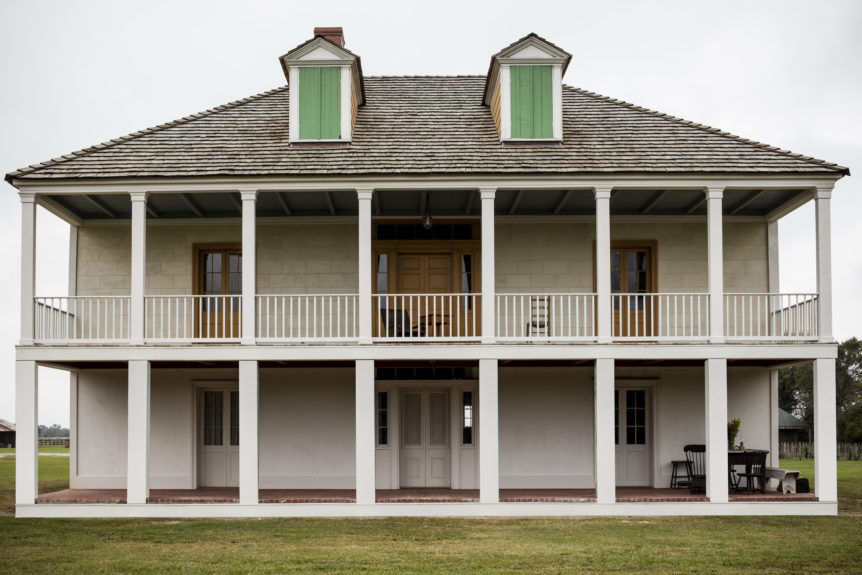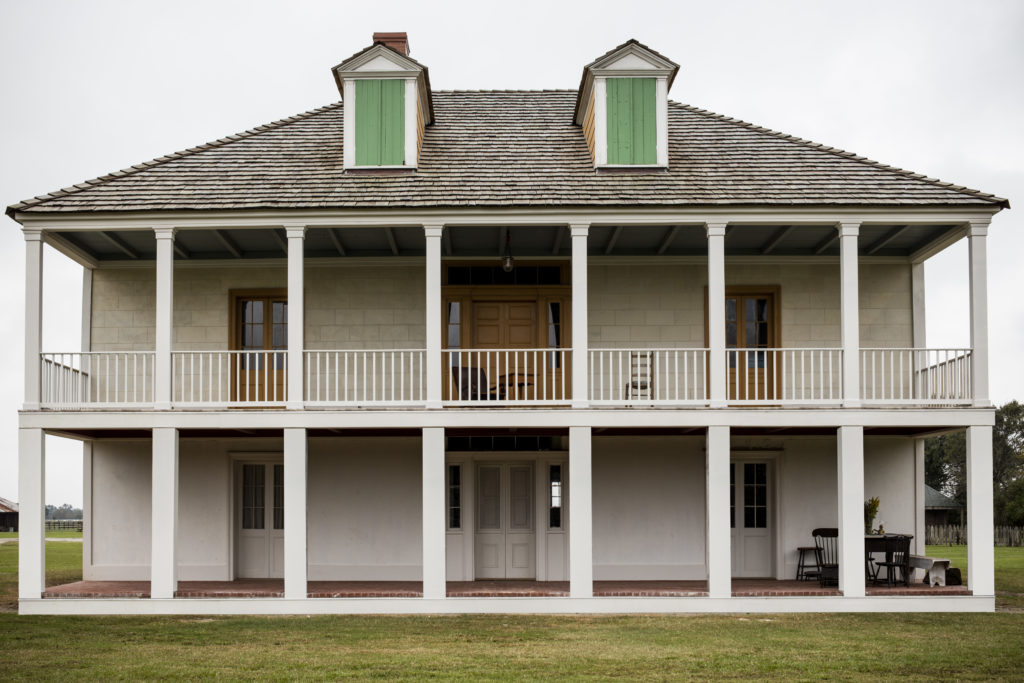
The 1840’s Creole house is from Kismet plantation. Unless otherwise noted, all photographs are by Richard Sexton.
In this fourth episode of Curious Objects, Benjamin Miller talks to Wade Lege, a Louisianan who’s restored a Mississippi bayou home. Of course, before the house could be restored, it had to be rescued: its original footprint is now underwater inside the levee. It’s filled with Lege’s collection of Americana, including a plantation desk with an amphitheater interior that he’s just tickled pink about.
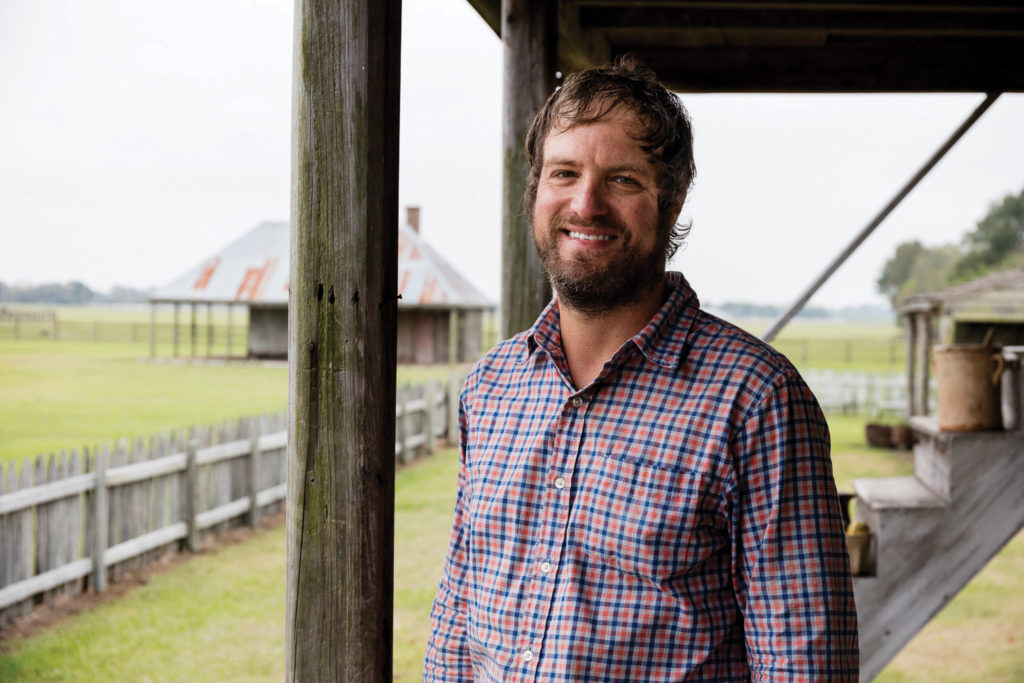
Wade Lege.
Wade Lege is a historic preservationist and collector who’s been snapping up regional material since he was in his early twenties. His antebellum Greek Revival house is the pièce de résistance on a Louisiana property that also includes a period kitchen recreation and a half-timbered cottage outfitted with the help of local craftsmen.
Wade Lege: Too many people buy too much crap. I only have to be around a few beautiful things.
Benjamin Miller: Welcome back to another episode of Curious Objects and the stories behind them, brought to you by The Magazine ANTIQUES. I’m your host, Ben Miller, and before diving in I’d like to draw your attention to a new book you may find very interesting: Classical Principles for Modern Design. It’s by Thomas Jayne, a New York–based interior decorator whose work is much-admired by the editors of The Magazine ANTIQUES. In this beautifully illustrated book, Thomas Jayne demonstrates the lessons in simplicity and balance that he learned from Edith Wharton and Ogden Codman Jr. So, look for Classical Principles for Modern Design by Thomas Jayne at your favorite bookstore or online retailer. Today I’m talking to . . .
My guest today is Wade Lege, a private collector in Louisiana who was actually featured in an article in The Magazine ANTIQUES by Chris Waddington. Wade is a collector but he’s also a restorer, specifically of old Louisiana houses, and today we’re talking about the one that he actually lives in: a nineteenth century Greek Revival plantation house that’s been burned, looted, neglected and pulled across the earth by mule and by truck. So, forget about theoretical knowledge, close your art history textbooks; this is real life, inside a real object. You’ll want to visit themagazineantiques.com to see photos of the house and its contents and one intriguing . . . or, I’d even say, haunting antique photograph of its former owners. Thanks so much to everyone who’s taken the time to send feedback on the podcast and ideas for future interviews. I love hearing from you, so please send an email to podcast@themagazineantiques.com. Thanks also for leaving a rating or a review on iTunes. Now let’s jump in with Wade Lege.
Wade Lege, thanks for joining me.
Wade Lege: You bet.
Benjamin Miller: Now, typically on this podcast I’m talking with people who have a specific object—a piece of furniture, a piece of jewelry, a painting—some relatively small and well-defined piece. And in your case we’re talking about something a little bigger than that, which is to say, your entire house. So for listeners who don’t have a photograph in front of them, tell me a little bit about the architectural style of the house and its appearance. It has a very impressive colonnade across the front.
Wade Lege: Well, it’s basically three rooms across the front—and the house is fifty feet wide, approximately—three equal-sized rooms. And then behind those three rooms are three additional rooms and then you have a, you know, basically a porch that spans the distance in front of the house. But then there’s also a porch in the back of the house. And these porches all fall under the same hip roof. And there are no extensions but on the rear porch you have a room on each end of the porch, or gallery, and those were called cabinets and they are just small rooms. Today, we use these cabinet rooms as bathrooms. Well, when the house was built, not to say they weren’t used as a bathroom, it could have been, you know, chambers and commodes in there, but typically there was a place away from the house for those uses. So, these cabinet rooms, I believe, were just, you know, originally maybe storage rooms.
“The house was built closer to New Orleans, along the Mississippi River, by a family who made money farming sugarcane.”
Benjamin Miller: This is a house that is actually not in its original location anymore. Is that correct?
Wade Lege: Not at all, no. The house was built closer to New Orleans and it was a river roadhouse, meaning it was built along the Mississippi River, and by a family who made money farming sugarcane.There were some things that allowed this to happen out of my control, and one of them was moving the house. That’s an expensive endeavor, and I was able to make a deal with someone in order to get this done. And, you know, there are some reasons out of my control that I actually did this project. But, you know. I don’t really recommend it.
Wade Lege: You know, it was originally raised seven/eight feet off the ground for reasons of flood control issues. You know, back in the nineteenth century there were no levees, there was no flood control whatsoever. Folks stored dry goods and other things, and often times there would just be wooden walls established between the piers, you know, the supports for the house itself, and that would be stored lock and key. Sometimes some houses were developed nicer than others, these basements, but they weren’t in the ground, you know, they were above ground. So, in the 19—I guess—30s the Corps of Engineers decided to increase the size of the levees in that part of the world and they began moving some of these houses. I understand that, you know, just as many more were destroyed as were saved, but once they were moved eighty yards or more they would not be raised seven or eight feet off the ground again, they would only be four feet or so on the ground. And that was the case with this house, and the original footprint of this house is actually underwater inside the levee.
“The Corps of Engineers decided to increase the size of the levees in that part of the world and they began moving some of these houses. . . . The original footprint of this house is actually underwater inside the levee.”
Benjamin Miller: Really?
Wade Lege: Yep.
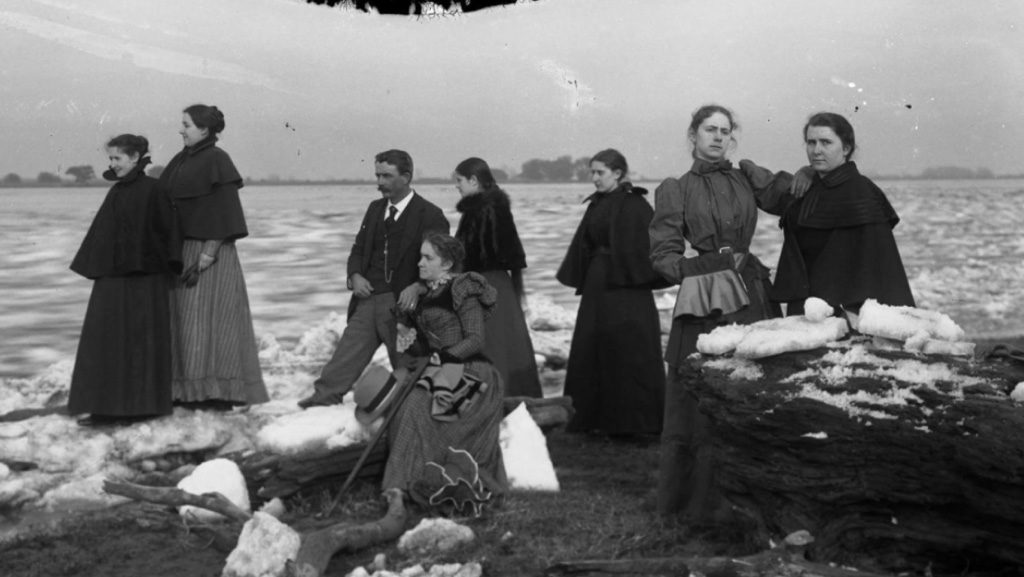
The house’s former owners c. 1899.
Benjamin Miller: So the whole farm, the whole plantation is no more?
Wade Lege: It’s no more. Now, sugarcane is still farmed in that area, and actually on the land where the house was. But, you know, all the glory of those days is long gone.
“The house was constructed in the 1840s and presumably built by a slave-owning agricultural family.”
Benjamin Miller: Let’s try to put this into a little bit of historical context. So, the house was constructed in the 1840s and presumably built by a slave-owning agricultural family.
Wade Lege: Yes.
Benjamin Miller: Do you know the family who built it?
Wade Lege: I have a photographic—dated 1899, I believe—and it is a photograph of the family members, and, oddly enough, they’re standing at the Mississippi and the Mississippi has floating ice in it. Evidently there was a strong freeze that year and these family members—looks like some brothers and sisters or maybe a man and his wife . . . but it’s certainly interesting, you know, there’s some travel trunks in the photo. I don’t know if they’re waiting for a boat or paddlewheel, but certainly with these ice chunks I can’t see navigation at that period. They almost look stranded but as I’m understanding they’re standing on there—at the Mississippi—on their property.
Wade Lege: That’s the only little hint of evidence I have. Let me say this, the town that the house was built in was a very prosperous river town in the nineteenth century. Certainly before the war. And when I mean prosperous, I mean prosperous. [There were] many other houses in the area, obviously not densely populated, but populated. And today there’s literally nothing there. It’s almost shocking because there is nothing but river activity inside the levee. There is nothing on the outside. I mean there are some chemical and petrol plants downriver and upriver from there, but there is no population.
Benjamin Miller: How times have changed.
“The town that the house was built in was a very prosperous river town in the nineteenth century . . . and today there’s literally nothing there.”
Wade Lege: Yes.
Benjamin Miller: So, what do you think likely happened to this house during and after the . . . in the aftermath of the Civil War?
Wade Lege: Well, they did the best they could, you know, that’s it. You know, I mean, they continued to do what they could. There is some history of the house at the turn of the century by people who lived in it. And there were some tales written and some stories written and some archives. I actually have seen some of the photographs that date a little bit later into the early 1900s, but nothing, you know, nothing that strikes anything interesting, you know, other than just ordinary life.
“So, the house had a fire in 2007 and it almost burnt to the ground.”
The house is pretty cool in the fact that the original plaster was still on the walls in the house. Now, this plaster was covered over with board and it was, I guess, sheet rock applied to these boards. So, the house had a fire in 2007 and it almost burnt to the ground. And, luckily, the fire department was able to put the fire out. And at that time the house had carpet, it had sheet rock, it had a sheet rock ceiling on the interior. All of this material had to be gutted, and in doing so the owners I bought the house from had no idea this original plaster was underneath all of this. And it was in terrible condition, I mean, you can imagine these boards being nailed to plaster being moved, when the Corps moved it, it was moved—could have been moved by animals, mules or, you know, the horses. It’s not always . . . they weren’t always moved by machinery.
Benjamin Miller: Really.
“There were six rooms. Two rooms were blue, two rooms were green, two rooms were yellow. It mimicked Mother Nature.”
Wade Lege: Yeah. And so there will have been a lot of jerking and a lot of it wouldn’t have been a smooth process. But what the color of the walls were pale yellow, a very pale green, and a type of very robin’s-egg light blue color, and those are the three colors. There were six rooms and, you know, two rooms were blue, two rooms were green, two rooms were yellow. And it was quite something to see. It mimicked Mother Nature, is what it did, you know.
Benjamin Miller: Wow.
Wade Lege: You know, the sun, the blue skies, and green all around us.
Benjamin Miller: And how do you restore that?
Wade Lege: You have a decision to make: You can you can live with it as it is, you can attempt to skim coat over it, which would essentially remove all the color; or you could take it down and start from scratch. And I chose to take it down and start from scratch. There was just . . . it was so bad it was unsightly.
Benjamin Miller: I see.
Wade Lege: Anyways, I was lucky to have enough people to help, and we took this broken plaster down and I kept many samples, obviously, in my hope, and I actually did one room in the yellow and that room is in the, was published in the magazine. And it came out great! You know, you’re able to buy the same product, milk paint, today. And milk paint is a wonderful thing and, you know, if a wall has fresh plaster on it it readily absorbs this milk paint quite easily. And it’s up to you how many coats you want to put on of this stuff but you can mimic nineteenth century quite easily these days.
Benjamin Miller: And you’ve actually learned quite a bit about nineteenth century construction methods, right?
Wade Lege: Well, again, you know, trial and error.
Benjamin Miller: Sure, sure. But, you know, it’s not everyone who would reconstruct plaster walls of an 1840 house.
“I just saw an opportunity to buy the house, and then when I was able to make a deal to move it, I already had the land, and I thought, ‘Here’s my chance if I want it.'”
Wade Lege: Oh, you know, suddenly, you know, I was in that reality is what it was. It wasn’t anything else but that. I didn’t think about what I was going to do necessarily. I just saw an opportunity to buy the house, and then when I was able to make a deal to move it, I already had the land, and I thought, you know, here’s my chance if I want it.
Benjamin Miller: Now, after the house was moved when the levees were put into place, you say in the 1930s, do you know if the ownership of the house remained in the same family at that point or . . . ?
“When I first looked at the house I thought, ‘Well, man. There are no doors on this house. It’s only boarded up by plywood. I’m just not interested.'”
Wade Lege: No, they changed hands. I don’t know how many times. But the house when it caught fire in 2007, it was being used as a rent house. And the people living there had been there for thirty years I understand. It was in very nice condition before the fire because I’ve seen a photo of it. And, unfortunately, after the fire it was vandalized. And I know this for a fact that the neighbors, having asked the neighbors, you know, “Were there any mantles, you know, fireplace mantles?” yes, they were there. And then it seemed like every three months or so the house sat empty, something would go missing, and then windows would become broken, and, you know. Luckily, the people who bought the house after the fire removed all of the French doors and the interior doors. When I first looked at the house I thought, “Well, man. There are no doors on this house. It’s only boarded up by plywood. I’m just not interested.” And the owner told me that they had removed the doors, and that the doors were in storage on their property. And he invited me to come and take a look. And so, of course, that piqued my interest more and when I saw the doors I basically made up my mind to make a slightly better offer and we were able to make the deal. They’re the reason why I bought the house, and it’s not just because of the doors, but the doors are incredibly beautiful. For instance, the glazed doors of what are call French doors are double doors. They have a double panel, which is unusual. So, there’s a large panel at the bottom, and then above that is a more narrow panel, and it’s just a nice, nice touch. And then the interior doors, they’re basically single doors, no glass, solid wood. Yeah, and the doors are incredibly heavy. You know, when the house was built, these large trees, the center of these large trees were kept for door-making and the reason being was the heart of a tree was the tightest grain and that grain would not warp. So you can make that door, and it would remain plum as a door as long as you would use the heart of a tree.
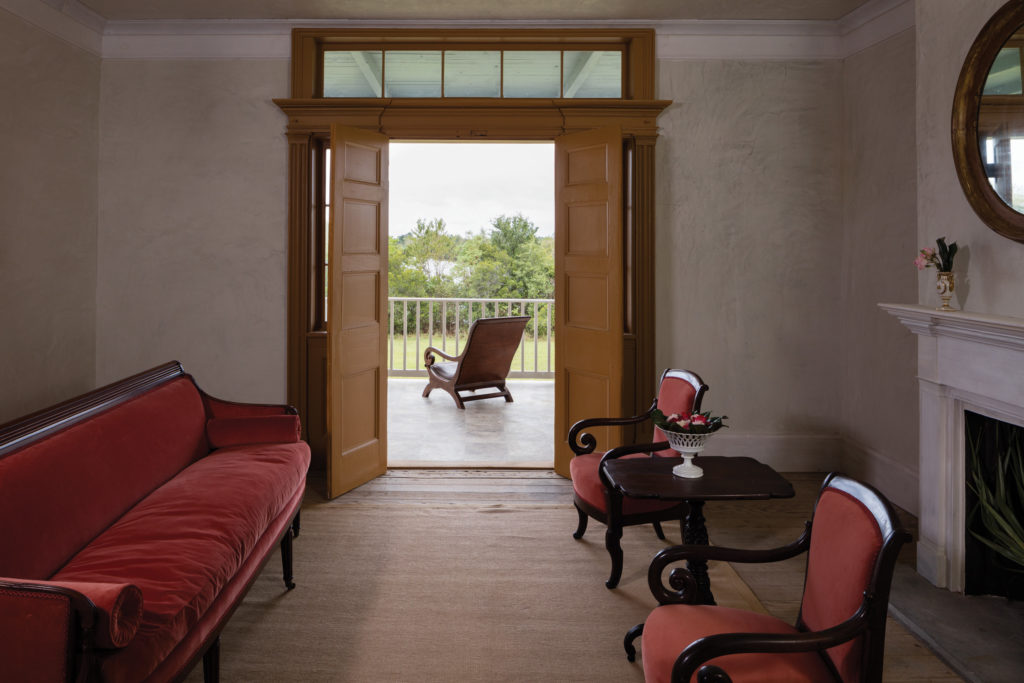
This suite of mahogany furniture includes a notable 1820s sofa from the Baltimore workshop of John Needles (1786–1878). The doors are original to the house.
Benjamin Miller: That’s fascinating. I didn’t realize that.
“When the house was built, the center of these large trees were kept for door-making. The heart of a tree was the tightest grain and that grain would not warp.”
Benjamin Miller: And I would imagine that, in part because of that reason, doors would be very appealing objects for vandals to steal and as reclaimed architectural elements.
Wade Lege: That and the mantles are the things that always get, you know, stolen.
Benjamin Miller: Well, and I suppose sometimes they’re stolen, and other times the owners just decide to cannibalize the house.
Wade Lege: And that’s possible. I mean, it’s like when you go to New Orleans and you go around New Orleans and you see, you know, great things, but then you go to the French Quarter and you start to see the early doors in the French Quarter and all and it just harkens back to another time, I guess.
Benjamin Miller: Let me change gears for a second and ask a little bit about your background and how you got interested in this kind of thing. You were born and raised in Louisiana. Correct?
Wade Lege: Yeah.
Benjamin Miller: Were you surrounded by antiques as a kid? Is that something your parents were into?
“When there was nothing else to do I would always daydream about some aspect of antiquity.”
Wade Lege: Not so much. My mother did have a shop with her sister, and it was basically a retail, new things. But we would take a trip to Dallas to go to this market, and inside of this market they did have old shops. And I remember being blown away by the history of some of these things I’m seeing. And then also, I guess, I had . . . my dad’s sister was in another part of the world in the Mid-East, in the Philippines and in England, her husband was a drill instructor for an oil company and they would send stamps and coins to me. And I was fascinated by what some of these things—what I was looking at. So I guess I would grab an encyclopedia, I guess try to figure out where and what is it like, where these things are coming from. I could always daydream when there was nothing else to do. I would always daydream about some aspect of antiquity, you know, I suppose. I didn’t start collecting anything regional until I was, I guess, nineteen or twenty years old, and I didn’t have any experience whatsoever with an old house, but I did like them. I remembered taking quite a few tours of early houses. Matter of fact, one thing comes to mind: We would take a boat to an area called New Roads which is north of Baton Rouge, and there was an old Mississippi River outlet. And it’s no longer part of the Mississippi and actually the water is very clear there. But there was a lot of skiing and there’s a lot of houses there, but on one side of it this waterway is still lined with plantations. I was always very keen to take the truck—I guess I just got my driver’s license—and I was too embarrassed to tell my dad that . . . you know, I’d make up a story like, “I need to go to a store” or something, and I would go, because my folks they wouldn’t, I don’t think, spend too much time driving around looking at old houses. But I sure fancied it. I’ve owned a lot of things that I have sold. You know, my first house—I have a small, historic, Acadian house that is on the property, and that was in Lafayette near the Interstate 10 highway system, and it was abandoned and they were going to tear it down and by word-of-mouth I found out about it and I was able to buy it. It took me a couple of years to finally move it. I finally got the little house, and I guess moved it in 2007, something around that year. I’ve been living in that little house up until about a year ago now, so, you know, that house—I was able to figure out a little bit more, you know, how plaster might work, and then more modern things like plumbing and electrical, and, you know, you need all those things these days, certainly I do. But— and there are some other buildings here on the property. I have a couple of outbuildings that I rescued and there’s another single-room house that appears to have been a larger part of a larger house that I rescued and, you know . . . I’m not looking to rescue any more buildings apart from this property at all.
Benjamin Miller: You’ve hit your quota.
Wade Lege: Yes. Oh, God, yes.
Benjamin Miller: Interested in the ins and outs of Doors? The rational handling of Rooms in General? Color? The Historical Tradition? These are all chapter headings in interior designer Thomas Jayne’s new book, Classical Principles for Modern Design, from Monacelli Press. Jayne advocates a middle road between innovation and tradition, reminding us that comfort in a home is paramount and that good design is as often a product of sensitivity to the past as it is of inklings of the future. Find Classical Principles of Modern Design at a bookstore near you or at monacellipress.com.
And with that, let’s get back to Wade Lege.
Well, now let’s talk a bit about the contents of the house, because you’ve filled this house with some very interesting antique objects.
“The great antiques are cheap these days, at least they are at the auctions I’m browsing.”
Wade Lege: Well, the great antiques are cheap these days, at least they are at the auctions I’m browsing, you know. Why that is, I think just things are out of style. Great American, you know, antiques or just—there are a lot of them out there these days coming up for sale, and if you’re patient you can nab, you know, a very nice piece that will, you know, will never go out of style. You know, a lot of things were built . . . in the day they were built they were just, basically, you know, crap, junk, and, you know, you want to try to stay away from those things, I believe.
Benjamin Miller: In terms of the pieces that you’ve been collecting for the house, are you looking for pieces that are consistent with the period of the house, or pieces that have regional connections? Or is this more about lifestyle and just finding nice and beautiful things to live with?
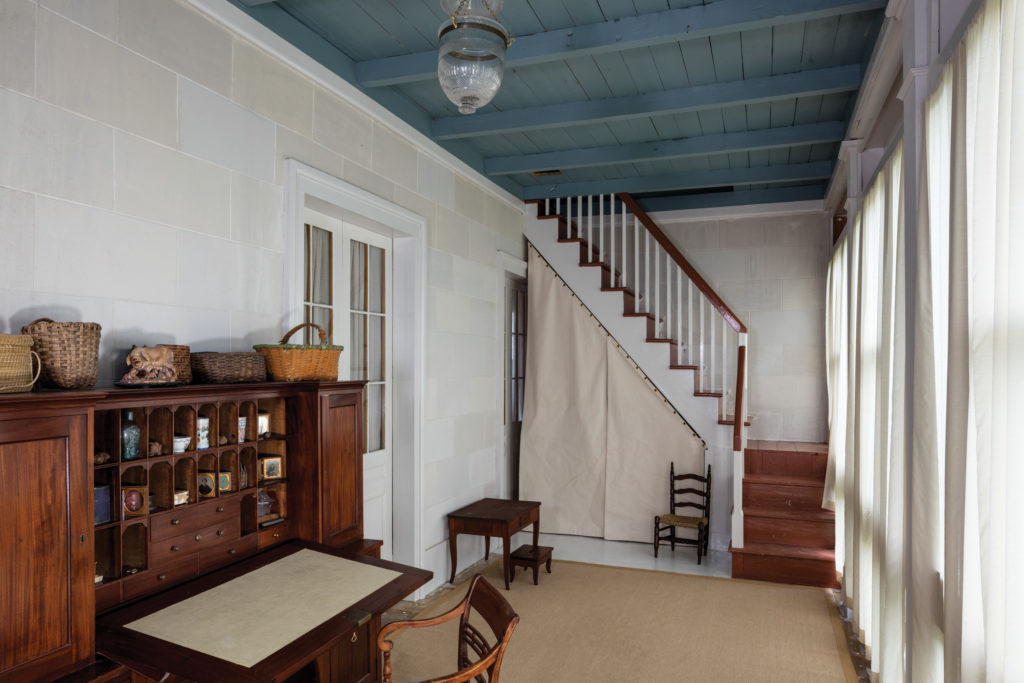
An 1840s plantation desk, made of cherry with cypress secondary wood, is the centerpiece of Kismet’s enclosed loggia.
Wade Lege: Basically all three. I’ve been collecting regional material for twenty years–plus, you know, luckily it’s out of Louisiana. There’s an abundance of regional antiques material culture that left in the form of furniture, in the form of textiles, in the form of buildings and outbuildings, in the form of more primitive items, like, you know, objects used for cooking. You know, there’s a lot of Louisiana-related antiques out there that, you know, twenty years ago, twenty-five years ago before we had, you know, the Internet and smartphones, the chase was kind of fun. You know, you could talk to some people and then someone would say, “Well, you know, in this barn on this person’s property I remember seeing such and such,” and, you know, it was always fun. You could always find some pretty cool stuff. You know, there are some collections out there, you know, down here, that are pretty amazing. I like the New York furniture makers and I like Baltimore as well, Boston as well. So, I’ve covered the gamut really.
Benjamin Miller: So, you’ve got pieces from all across the Eastern Seaboard, then?
Wade Lege: Yeah, pretty much. Yeah, absolutely.
“I’ve been collecting regional material for twenty years–plus.”
Benjamin Miller: And, I suppose, frankly, the original owners of the house might well have been buying furniture from New York just as they might have been buying furniture from England.
Wade Lege: Absolutely. I mean, you had retailers in New Orleans selling not only New Orleans–made things but also retailing for furniture from other parts of the East Coast and the mid-Atlantic states. Certainly, just some of the best purveyors of antiques and furniture and whatnot are from that part of the Eastern Seaboard. So, you know, it’s not hard if you wait and wait and you can find, you know, there are some great, like, Mississippi, for instance, there are some great Eastern Seaboard pieces coming out of these houses in Mississippi. And, you know, what’s funny is, they have been in these same houses since they were purchased in the first half of the nineteenth century.
Benjamin Miller: It’s amazing.
Wade Lege: Yeah, it really is. And their climate, you know, once you get going up a few states or so, it’s just less humid. And so the preservation of material is better than it is, say, in New Orleans, with all the humidity.
“I have a friend in California who pays attention to estate sales around Los Angeles. I have a friend about an hour outside of Pittsburgh who does some traveling in that part of the world. There’s an auction house in New Hampshire, and there are some great auction houses in New Orleans.”
Benjamin Miller: So, let’s go back for a second. I want to ask you to talk a little bit more about the sources of these objects because you’re not just buying at auction houses. You are buying at auction houses, but it sounds like there are other ways that you’ve come across interesting pieces.
Wade Lege: It’s kind of word-of-mouth. I have a friend in California who pays attention to estate sales around Los Angeles. I have a friend about an hour outside of Pittsburgh who does some traveling in that part of the world. He’s from here originally. Well, I got to know them all here. You know, there’s an auction house in New Hampshire and then there are a couple all the way down that I pay attention to. And, you know, there’s always something but there are some great auction houses in New Orleans. So there’s always something coming up. There’s a good one in Mississippi, there’s been some great auctions recently that have come out of Alabama. Christie’s had an amazing auction recently of contents of a house in Alabama, I mean, just amazing.
Benjamin Miller: Do you have a particular favorite piece in your house right now that you’d like to tell listeners about?
Wade Lege: There was a cherry and cypress plantation desk that is Greek Revival–style. I would guess 1830s. It has an amphitheater interior which just means it’s four-tiered, four-leveled with drawers in the first two levels and then basically arched openings. The shelving are all . . . they’re finished with scalloped edges and cherry. So, in other words, most of the shelf is cypress but then the very front of it is this scalloped edged–decorated piece of cherry. And it came up auctioned in Mississippi of all places and I feel very fortunate to have gotten it. That has become a favorite piece of mine simply because we use it everyday.
Benjamin Miller: There’s nothing to make you fall in love with a piece like putting it to good use.
“There’s a cherry and cypress plantation desk that is Greek Revival–style . . . that has become a favorite piece of mine simply because we use it everyday.”
Wade Lege: I know. It’s so compartmentalized that it stores last week’s stuff, last month’s stuff, and last year’s stuff, you know, so I know where last year’s things are, I know where the current things are, and . . .I’m just tickled pink to have it, I’ll be honest with you. It’s, you know, it’s just a very fine thing. And what’s funny is the man who delivered it to me he said, “Did you see this thing?” I said, “Well is it nice?” He said, “Oh, it’s nice,” he said, “Normally you find signature on pieces like this.” But, he said, “Loading it up, I looked,” he said, “I didn’t see a signature.” Now, this man handles a lot of stuff, and for him to talk nicely about it . . . I couldn’t wait to finally open it. He’s telling me all this, you know, this is the first time I’m seeing it because I only bought it online, you know.
Benjamin Miller: That was a pleasant surprise.
Wade Lege: Very much it exceeded my expectations.
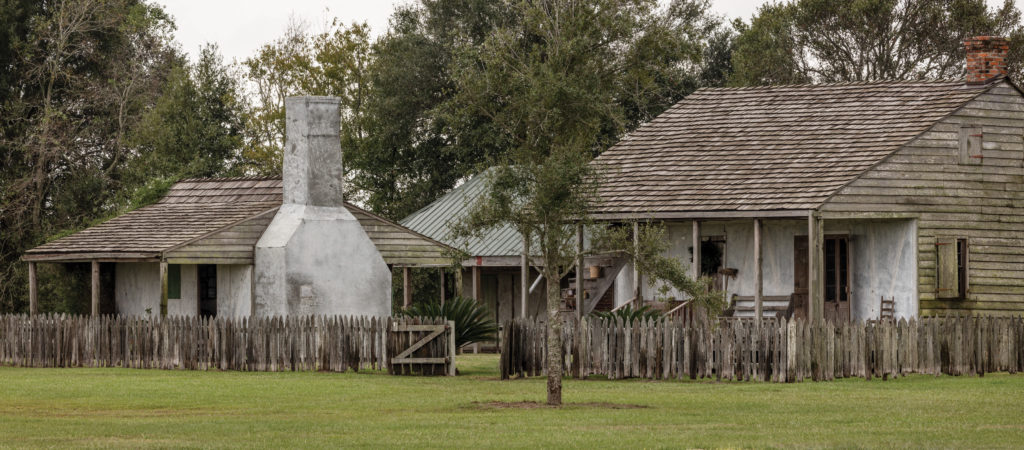
Eighteenth century half-timbered cottage and period kitchen re-creation, near Abbeville.
Benjamin Miller: And I have to say, I think that speaking of this notion that using something can make you love it more, I’m sure you can say exactly the same thing about your house, and one of the interesting things to me about the process of restoring a house to live in is it’s very different from the process of restoring a house to make it into a museum, for example, where people will come in and have the opportunity to see this wonderful historical relic but nobody is going to have the chance to experience what it was like really to live in it and to see the purpose that it was made for. But you, day in and day out, have that experience. You, as you say, you’ve got a modern kitchen and certain modern conveniences, but you’re also in a very real sense surrounded by the vestiges of this almost two hundred year–old culture. Tell me a bit about . . . do you feel closeness? Do you feel sometimes that you’re living in a time machine? Do you imagine the families that have come before you? What’s the daily experience like of living in a house with that kind of a history?
Wade Lege: I suppose I guess I do feel privileged in some aspects, but, again, the restoration of it was so difficult and took so long and basically, you know, bankrupted me for, you know, four years, that I feel like I did put some effort into its history. I don’t know. I don’t think about those terms too much. I mean, it’s just really shadow lines at the end of the day. And, you know, what I mean by shadow lines is just the detail and molding sequence, I guess, in parts of the house that you only see in a certain time in the nineteenth century. You know, living in an old house is interesting. I love the floor plan of the house and that’s something I wanted to mention. That was one of my favorite—that was my favorite thing about the house when I saw it the first time was the floor plan. And it just simply allowed for two separate apartments on both ends of the house. I mean, you know, one end of the a house mimics exactly the other end. The doors are in the same place, the rooms are the same size. There are no surprises, no weird turns, there are no hallways. And I thought, well, you know, this is pretty cool. I mean, I don’t—you know, I had a girlfriend at the time that . . . we had been together for many years. And I certainly hope . . . did not see that changing—matter of fact, we’re in the house together today, she’s now my fiancé—but she has her side and I have mine. And, of course, we do share the same side together, often. However, when she needs to—she’s an attorney—when she needs to sit down and do her work, or, you know, if for whatever reason I’m doing something on my side . . . so it allows for some freedom for us, and some space and some elbow room.
Benjamin Miller: I guess Ben Franklin is right about good fences making good neighbors as well.
Wade Lege: And you know you want a nice fence. (laughter)
Benjamin Miller: Let me move in the direction of wrapping up, here. I want to ask you a couple of questions that I ask all of my guests. The first one is, What is a mistake that you see other collectors—or people who are involved in this kind of restoration area—what’s one mistake that you see them making that you would caution them against?
“Too many people buy too much crap.”
Wade Lege: I would say, you know, it’s good to collect and to have an old building you love. You want to make the house for yourself to live in. I would caution against not making it as a museum as you might have intended to or, I guess, as authentic as you might have intended to. Because, you know, you want things to work, you want to live in it, and you need it . . . you may want to multi-use the building. In other words, you may want to event rental the building, or you may have some other ideas later down the road that you don’t see coming and you may want to allow yourself some room to do that. As far as collecting, too many people buy too much crap . . .
Benjamin Miller: (laughter)
Wade Lege: It’s true. And too many people hoard. Too many collectors have too many things. I have to be around only a few beautiful things and I guess that’s different in everyone’s mind and taste. But I do see a lot of junk amongst a lot of people’s beauty, or, you know, you’ll see some beautiful things and then a lot of junk, and, you know, you’ve got to wonder, you know. So, collecting is, you know . . . I’m a poor man’s, you know, a classical dealer or buyer. You know, this is a poor version of the classics over here. I did not have a great budget to collect, and. I’m very fortunate these days that how affordable great American pieces have become. Fifteen years ago it was very different. You know, things had strong value and great things had even stronger value, and the only thing that has maintained its value is the art. Actually, the art has gone up. Regional art has skyrocketed, and art in particular has not fallen. Furniture and other objects of art, decorative arts, people are . . . I mean, candlesticks don’t even sell anymore. I don’t care how nice, how decorated the furniture, you know, it is shocking that many things European will find buyers at auction with what I consider kind of eye-opening prices, and, however, the much more refined, much more elegant, much more beautiful American piece is just sitting there with no interest.
“Consider the elements of the weather—Mother Nature—for one. Consider your budget and consider the time it takes on your lifestyle . . . you have to have a come to Jesus moment about, Do I really want to get involved with this or not?”
Benjamin Miller: Is there any other advice that you would give to a listener who, for example, is listening to you right now and thinking maybe he or she wants to put some sweat equity into a house and restore it and live in a beautiful historic home? What advice would you give to someone who’s thinking about just starting out in that process?

Independent collector Wade Lege on restoring a Mississippi bayou home and filling it with Americana.
Wade Lege: Consider the elements of the weather—Mother Nature—for one. And consider the fact that it’s not going to go as planned. Consider your budget and consider the time it takes on your lifestyle. In other words, the sweat equity you’re talking about, well, you need time to revamp and revive yourself from this sweat equity. Well, you’re normally so broke you can’t even take a vacation, and you’re normally so tired you don’t even want to. So, you know, depending on whether you have to move the house, or, you know, if it’s just a mild restoration that’s fine, but . . . Old buildings are great, I would just say, you know, you have to have a come to Jesus moment about, Do I really want to get involved with this or not? I guess that, you know, of course, price—if you can get involved in something on the cheap, then by all means, it’s probably worth it. But, if it’s going to be a struggle, and it’s going to be a struggle for a little while and that little while turns into a little bit longer because of things out of your control, it gets to be a thorn in your side. And, you know, I can remember many times people saying, “well you know you don’t come to New Orleans anymore.” I’m like, “Listen, I’ve got a list of reasons why you don’t see me anymore. The top of the list is money. The next thing is I’m too tired. And, you know, the third thing is, you know, I gotta start back up on this in the next day or two and I’ll be driving back to New Orleans. I’m not about to”—it’s just too much. I know that there are many beautiful, many beautiful properties that need restoration in many parts of the United States. And, you know, I would tell anyone to certainly consider that. But tools break, for instance, and then suddenly you’re sitting there, you’re making no progress whatsoever, and this dream starts to seem like a little bit of a waste of time maybe. That’s the reality of it, you know. It’s the—oh, you look and you have rose colored glasses—well, that may be true, but the reality is that you have to have a lot of patience if, you know, if you embark on something that is maybe more than you can handle. I’ve heard of pretty amazing stories of people doing just that, buying into more than they could handle. Often a building will just stay tarped for years, because they can’t even get the, you know, the roof can’t even come together, and for whatever reason . . . a surprise in their life, an injury, a this that and the other. If you aren’t a good cook, get something good to eat, you know?
“There are many beautiful properties that need restoration in many parts of the United States. I would tell anyone to certainly consider that.”
Benjamin Miller: Well, there you have it. Hard to argue with that. That’s all for this episode. Thanks to my guest Wade Lege, don’t forget to check out the photos on themagazineantiques.com, and send me your thoughts and suggestions at podcast@themagazineantiques.com. Make sure you’re subscribed so you don’t miss future episodes. Next up we’re going to have a really exciting, special two-part episode straight from the Winter Antiques Show here in New York City where I’ll be talking with a host of dealers about objects of all stripes. You won’t want to miss it. In the meantime, if you’re a lover of great design from any era, I invite you to check out The Magazine ANTIQUES’s sister publication, MODERN magazine. MODERN provides a lively yet discerning take on the world of late twentieth century and contemporary design and decorative arts, offering information and inspiration to collectors and decorators alike. Take a look and subscribe at modernmag.com. Curious Objects is a podcast from The Magazine ANTIQUES, our editor is Sammy Dalati, music is by Trap Rabbit, and I’m your host, Ben Miller. Thanks for listening.

Wade Lege.
Wade Lege, an independent collector and subject of the fourth installment of Curious Objects & the stories behind them.
For more Curious Objects with Benjamin Miller, listen to us on iTunes or SoundCloud. If you have any questions or comments, send us an email at podcast@themagazineantiques.com.

